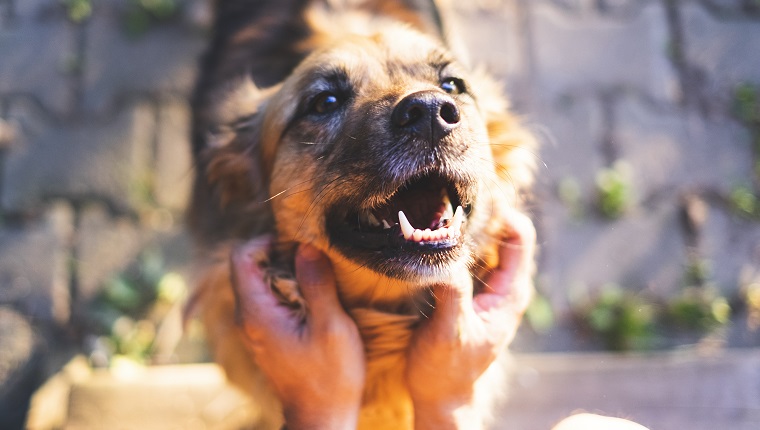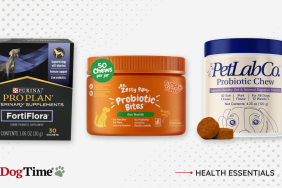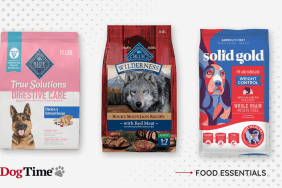Just like with human health, dental care is an important component of your dog’s overall wellness. It may not be as easy as other things we do to take care of our dogs, like brushing their fur. But taking care of their gums and teeth can lead to better long-term health for your pup.
While it may seem intimidating or daunting to stick to a good dental care regimen for your dog, the good news is that you can keep up with your dog’s oral health by focusing on just a few key elements.
Here are a few things pet parents should focus on when it comes to their dogs’ dental care.
1. Check Your Dog’s Mouth Regularly
Besides just admiring your dog’s dazzling smile while they charm you for treats, it’s a good idea to examine your dog’s mouth about once a week.
Teeth should be more white than yellow with no brownish tartar or plaque on them, which can tend to accumulate near the gums. Gums should be nice and pink, not white or red, and there should be no swelling.
You should see your veterinarian if you notice any of these signs of poor dental health in your dog’s mouth.
There are other signs that your dog may need professional care for their dental issues. These signs include:
- Excessive drooling
- Lack of appetite
- Changes in the way your dog eats or chews
- Misalignment of teeth
- Bad breath
- Broken or missing teeth
- Bumps or growths within the mouth
2. Regular Vet Visits
Speaking of seeing your veterinarian for help, your dog should be getting a regular dental exam once or twice a year.
Most vets will include this as part of their regular annual check-up, but be sure to ask if you don’t see it being done.
Professional dental cleanings may be expensive, but they are quite effective, and it’s important to have a professional monitoring your dog’s dental health over time. While these annual or semi-annual visits are key, it’s also important to maintain a regular teeth cleaning regimen at home.
3. Brush Their Teeth
Brushing your teeth regularly isn’t just for humans. If possible, try to brush your dog’s teeth every day, or at least a few times a week.
While your minty or cinnamon toothpaste may smell good to your pup, you must not use human toothpaste for them. Dogs will swallow the paste, and several ingredients in human toothpaste are toxic to them.
Be sure to get a toothpaste specially formulated for dogs. Many dog toothpastes have flavors like chicken or peanut butter, and your dog will thank you for that!
Ideally, you can start the habit of brushing your dog’s teeth when they’re puppies so they can get used to it from a young age. However, it’s still possible to “teach an old dog new tricks.”
Some simple techniques can get your dog used to handling their mouth. Try putting a bit of soft food on your finger, like peanut butter or yogurt. With both, make sure to go for natural ingredients, and definitely avoid xylitol, which can be fatal to dogs.
Move your finger with the food on it around their mouth, allowing them to lick it while your other fingers touch their teeth. Also, try putting your hands gently on the top and bottom of their jaws, gently opening and closing the mouth.
Once they’re somewhat comfortable with these actions, they should be more ready to let you brush their teeth with a bit less fuss. Let them sniff the toothpaste before you put the brush into their mouth.
4. Use Brush Alternatives
If your dog just won’t tolerate tooth-brushing, even after you try easing them in, there are a couple of alternatives you can try.
You can use dental wipes to wipe your dog’s teeth regularly, which isn’t quite as effective at getting all the crevices in your dog’s teeth, but it’s still a pretty decent option. These can be especially useful if you’re on the go and your dog’s mouth just needs a quick cleaning.
There are also water additives that can keep bacteria at bay and reduce plaque and tartar build-up in your dog’s mouth.
With all tooth-cleaning options, be sure to consult your vet to find the best match for your dog.
5. Food, Treats, And Toys
Food, treats, and toys can also be great deterrents for plaque build-up for your pup.
Even if your dog may be a senior with fewer teeth remaining, vets still often recommend crunchy food for them over soft food. Crunchy food scrapes the teeth in a positive way, whereas soft food can stick to the teeth more easily.
Many dog treats also have dental health additives that help to keep your dog’s teeth clean. Their structures can be helpful in scraping away plaque, and so can some toys.
Make sure to choose safe, vet-recommended options, as treats or toys that are too hard can actually do more damage than good.
How do you take care of your dog’s teeth? Are there any tips that you find to be most helpful? Let us know in the comments below!
Sources:









